The U.S. trucking sector transports about 72% of the country’s freight by weight. But here’s the catch: inefficiencies still chew up billions each year. For example, congestion alone costs freight forwarding and shipping companies more than $94 billion in lost productivity in 2023, according to the American Transportation Research Institute.
Many logistics management teams still operate on separate tools, such as ERP for finance, Salesforce or another CRM for customer accounts, WMS for warehousing and logistics, and transportation software for dispatch and drivers. The problem? These systems don’t naturally connect. Shipments get delayed, billing cycles slow down, fleets sit idle, and customers grow frustrated.
That’s where supply chain integration and logistics software come in to make a real difference. When transportation platforms connect with ERP systems, CRMs, supply chain solutions, telematics, and dashboards, leaders get a single, unified digital ecosystem. This means cutting costs, improving service, and scaling operations more efficiently as demand increases.
Discover how a modern transportation management system can simplify your logistics operations.
Why Integrations Are Needed in Logistics and Supply Chain Optimization
A modern global logistics operation relies on multiple systems working in harmony. Without integrations, each system becomes an island. Let’s look at what that means in practice:
- Dispatch doesn’t know when the warehouse is ready - trucks wait idle.
- Finance teams don’t get trip costs in real time - billing delays and revenue leakage.
- Customer service lacks live shipment updates - frustrated clients and poor visibility.
- Drivers or operations staff duplicate entries in different systems - errors multiply.
In short, disconnected systems mean wasted time, higher costs, and missed opportunities for third-party logistics (3PL) providers. Explore our logistics services designed to cut costs and boost efficiency.
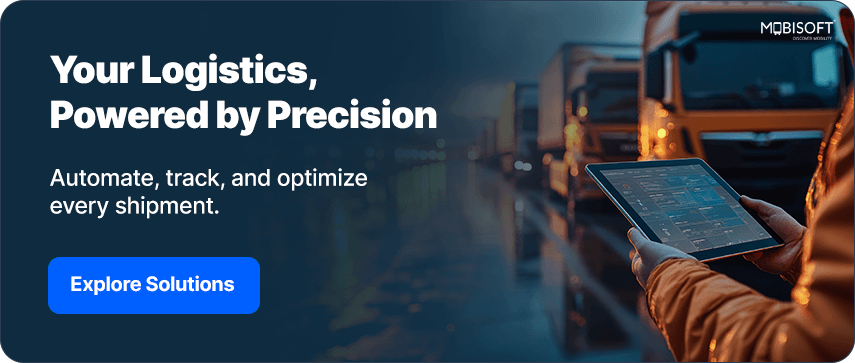
What Integrations Solve for Logistics Services
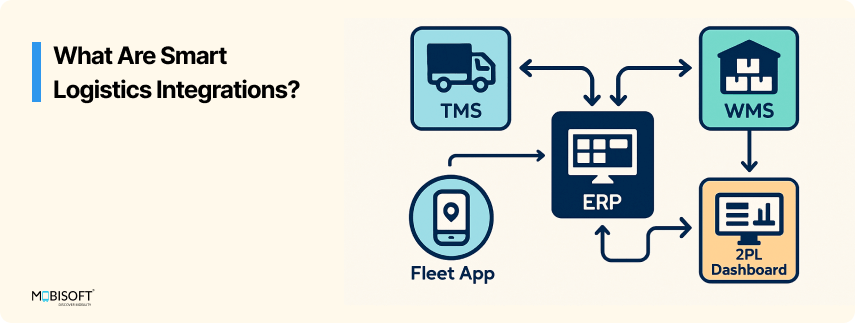
Logistics and transportation technology integrations act as the digital glue that ensures every system shares data automatically:
- ERP Integration in Transportation - Trip costs, invoices, and fuel expenses sync directly with SAP, Oracle, or Dynamics.
- Salesforce Logistics CRM Integration - Customer orders create shipments, and live ETAs appear for service reps.
- WMS and Transportation Software Integration - Align truck schedules with loading windows to reduce waiting and missed slots
- Telematics Integration - Feed real-time vehicle health and driver data into dispatch for safer, smoother operations.
- Transportation Analytics Dashboards - Platforms like Power BI or Tableau pull key indicators together, cost per ton-mile, utilization, and emissions, giving clear insights all on one screen.
The goal is to save time, save money, and improve reliability as the company grows, without chaos. See how real-world supply chain integration delivers measurable business value.
Core Logistics Software Integrations for 3PL Success
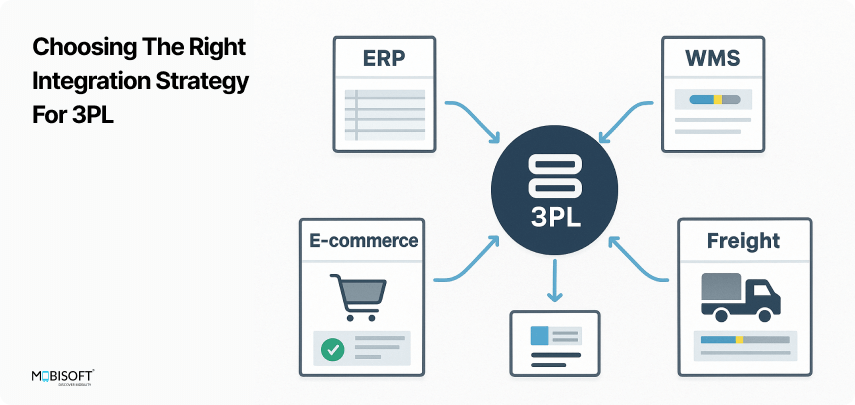
ERP Systems (SAP, Oracle NetSuite, Microsoft Dynamics 365, Odoo)
ERPs act as the financial backbone for logistics. Connecting transportation software with ERP systems means that trip invoices, driver allowances, and maintenance costs are captured automatically. This cuts down manual work and speeds billing.
Take a U.S. mining operator, for example. They link SAP with their transport management system, so as soon as the ore ships, trip costs are logged instantly in their ERP. The result: up-to-the-minute financial accuracy.
Supply Chain & Logistics Platforms
Supply chains change constantly. If fleet and warehouse teams are not in step, delays hit hard. Integrating transportation systems with logistics and supply chain optimization tools has a real payoff: no more trucks sitting idle, fewer bottlenecks, and less firefighting on last-mile delivery solutions.
Here’s a practical example. A big online retailer links transportation and warehouse software, using Descartes, to lock delivery windows to pick-pack times. The result? On-time fulfillment jumps.
CRM Systems (Salesforce, HubSpot, Zoho)
Customer trust depends on transparency. Integrating Salesforce with logistics software lets shipments get booked directly from sales opportunities. Service teams get real-time shipment updates, so there’s less chasing and more confident communication.
One U.S. freight forwarder uses this setup when a sales rep wins a deal; shipment booking happens automatically, with the journey tracked inside Salesforce Service Cloud.
Mapping & Routing APIs (Google Maps, HERE, Mapbox, OSM)
Routing defines logistics efficiency. Connecting transportation platforms with mapping APIs ensures accurate ETAs, geofencing, and routes that avoid congestion.
For example, a cross-border logistics provider uses HERE API to optimize routes, factoring in customs checkpoints. The outcome? Fewer delays and more predictable deliveries.
Telematics & IoT (Geotab, Samsara, Trimble, Verizon Connect)
Bringing telematics data into transportation platforms means real-time monitoring of fleet health, driver habits, and compliance. This leads to better safety and cuts down on surprises.
An energy logistics company, for example, integrates Samsara telematics with dispatch. Predictive maintenance alerts stop costly breakdowns during critical cold chain logistics fuel deliveries.
Business Intelligence & Analytics (Power BI, Tableau, Looker)
Data makes or breaks good decisions. Bring those KPI dashboards online. Focus on cost per ton-mile, driver time on the road, and emissions, so the team gets a read on where they are and where changes work best.
A U.S. steel distributor taps Tableau to analyze route efficiency. They manage to cut fuel consumption and trim logistics services costs by over 12% a year.
Payment & Billing Systems (Stripe, PayPal, Razorpay)
Streamlining payments ties up loose ends fast. When the payment platform syncs with logistics tools, billing, driver allowances, and account settlements just roll forward, with fewer errors and delayed checks.
Let’s say a third-party logistics (3PL) firm uses Stripe to send out driver payments right after trips finish. Admin headaches go down, drivers get paid, and nobody’s chasing paperwork later.
Learn how to select the right transportation management system for your growing business.
Integration Capabilities of Our Transportation Solution
To support these diverse needs, our transportation platform is built with enterprise-grade integration capabilities:
Expose APIs
Clients get REST APIs with webhooks, so real-time updates flow freely. OAuth 2.0 authentication, encrypted data, and full docs? That covers security and makes connecting any ERP, CRM, or BI tool a plug-and-play deal.
Business Value: Updates happen accurately, eliminating slow manual data transfers everywhere needed.
Integrate Client APIs
Need to link with Salesforce, SAP, Oracle, or platforms like Geotab and Samsara? No problem. Direct connections mean polling, webhooks, SFTP, and even EDI; what fits the stack stays in place. All systems pull together as a single source of truth without forcing anyone to rebuild or overhaul what already works.
Business Value: Integrations eliminate redundant tasks, unify data streams, reduce confusion, and deliver accurate answers quickly.
Implement Middleware
For complex ecosystems, we offer middleware-based integrations using iPaaS solutions (MuleSoft, Boomi, Workato) or lightweight hosted microservices. These handle schema mismatches, caching, throttling, and compliance-driven audit trails.
Business Value: Reduces integration risks, supports scalability, and ensures compliance in regulated industries.
Understand the role of technology in supply chain integration for transporters and fleet operators.
How We Implement Integrations
To ensure integrations are both reliable and aligned with client objectives, we use a structured and collaborative approach that balances business needs with technical precision.
Understand the Integration Points in Logistics and Supply Chain Solutions
Every project begins with discovery. We map the client’s current technology stack ERP, CRM, SCM, telematics, and other platforms and identify where data needs to move. This stage involves working closely with operations leaders to understand day-to-day bottlenecks and with IT teams to capture system dependencies, security requirements, and compliance considerations. The outcome is not just a list of integration points but a clear picture of business priorities that these logistics and supply chain optimization efforts will solve.
Brainstorm & Finalize the Approach for Third-Party Logistics
Once we know the “what,” we move to the “how.” This is a collaborative phase where we bring together three perspectives:
- The client’s technology team ensures alignment with existing infrastructure.
- The third-party logistics software providers (e.g., SAP, Salesforce, Geotab) share technical guidelines and constraints.
- Our integration architects recommend the most suitable design, be it direct API connections, middleware-based orchestration, or a hybrid model.
Instead of a one-size-fits-all method, we co-create an approach that balances security, scalability, and long-term maintainability. This avoids costly rework and ensures all stakeholders buy into the solution upfront.
Test in Real Scenarios with Logistics and Transportation Technology
Testing goes beyond checking if systems are “connected.” We simulate real business scenarios to validate that data flows support actual operations. For example:
- Does a shipment created in Salesforce automatically generate a dispatch-ready record in the transportation system?
- Do trip invoices posted in the transport platform reflect in SAP with the correct cost center and GL codes?
- Does telematics data from Geotab sync in time to trigger predictive maintenance alerts?
We also build in resilience testing - what happens if an API call fails, a system is temporarily offline, or data is malformed? Automated retries, alerts, and reconciliation processes are validated to ensure the integration won’t collapse under real-world conditions.
Deploy with Monitoring Across Global Logistics Networks
Deployment is not just about “switching on” integrations. We plan rollouts carefully, choosing between phased deployments (starting with a subset of integrations or regions) or full go-live depending on business priorities and risk appetite.
Once live, integrations are continuously monitored with dashboards and alerting systems that track sync health, latency, and error rates. We also implement contingency plans and rollback strategies, ensuring that even if a disruption occurs, operations remain unaffected. Post-deployment, our team works with client IT staff to fine-tune performance, adjust for evolving business needs, and document change controls for future scalability.
Benefits of Integrated Logistics Transportation

When transportation software fits well with enterprise systems, the effects spread throughout the company. Let’s look at what this means on the ground.
Real-time visibility across fleets, warehouses, and finance
Managers avoid waiting for manual updates or digging through spreadsheets. They get real-time views of vehicle locations, shipment status, and costs on a clear dashboard, helping them spot and fix issues quickly.
Optimized operations that reduce idle trucks and empty miles
Integration matches transport schedules with warehouse readiness, customer demand, and driver availability. Trucks spend more time on the move and less waiting, improving fleet utilization and cutting costs.
Faster billing and settlements through automated ERP and payment workflows
Costs like trip expenses, invoices, and driver allowances pass straight into ERP and payment systems automatically. Paperwork drops, errors reduce, and cash flow speeds up, improving working capital.
Improved compliance and safety via telematics and workforce integrations
By linking telematics and HR systems with transport software, companies track driver hours and vehicle health for real-time compliance. This lowers violations, reduces accidents, and keeps operations legally on track.
Strategic decision-making powered by unified analytics dashboards
Unified dashboards give key insights on metrics, as cost per ton-mile, on-time delivery, and emissions per shipment. These help drive smarter planning and support sustainable growth.
Improve visibility with advanced freight tracking and visibility tools built for logistics teams.
Future Outlook in Logistics and Supply Chain Integration
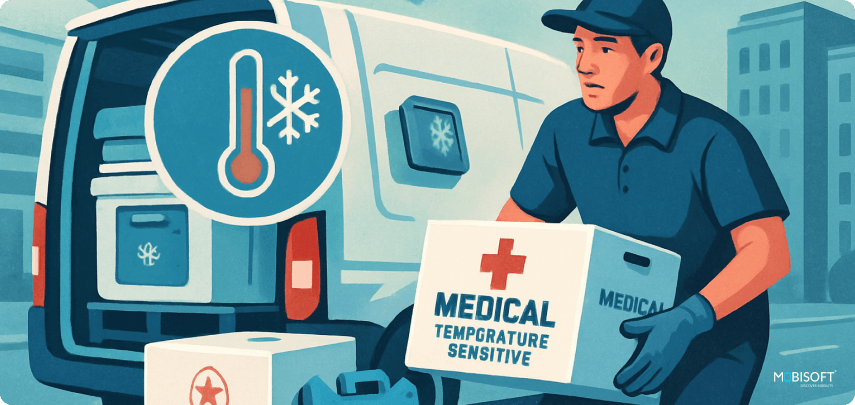
The future of logistics services integrations is not about distant possibilities, but about practical innovation. Over the next few years, companies across all sectors will invest heavily in systems that boost efficiency, reliability, and customer trust.
Enterprise 3PLs focus on tighter links between warehousing, transportation, and customer service systems. They expect more ERP-TMS integrations to improve financial clarity and use AI tools that sharpen delivery estimates and adjust routes in real time. Many 3PLs are also adopting sustainability dashboards to track fuel usage and emissions, providing clients with transparent ESG reporting.
Industrial and Mining Logistics players are turning to transportation management systems (TMS) integrated with ERP and telematics to improve safety and asset utilization. Real-time vehicle tracking and IoT-enabled fleet monitoring will help prevent costly delays and keep bulk shipments moving without disruption. Advanced analytics will give managers insights into bottlenecks and allow them to optimize resource use.
Retail and e-commerce supply chains sync order systems with last-mile delivery solutions. The goal: give customers live tracking, timely alerts, and faster deliveries. Merging WMS, TMS, and CRM data enables smarter routing, fewer missed deliveries, and meets rising demands for speed and clarity.
Mid-size dispatch and transport operators adopt cloud-based TMS platforms plugged into mapping, payment gateways, and electronic proof of delivery apps. Moving past spreadsheets, these operators now run fully digital workflows, with live fleet tracking and instant customer updates, features once limited to big players.
Stay ahead with insights into the future of logistics services and supply chain technology.
Conclusion
Disconnected systems silently drain billions from logistics operations. The future of the industry lies in creating a fully connected ecosystem, where transportation software is the central hub linking ERP, CRM, supply chain solutions, telematics, and analytics platforms.
With the ability to expose APIs, integrate client APIs, and implement middleware, our transportation solution ensures that every part of your third-party logistics operation works in sync, improving efficiency, cutting costs, and building trust with customers.


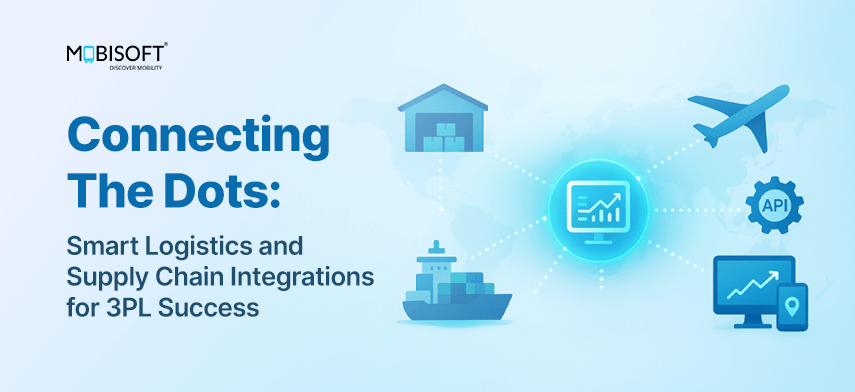


 July 7, 2025
July 7, 2025


